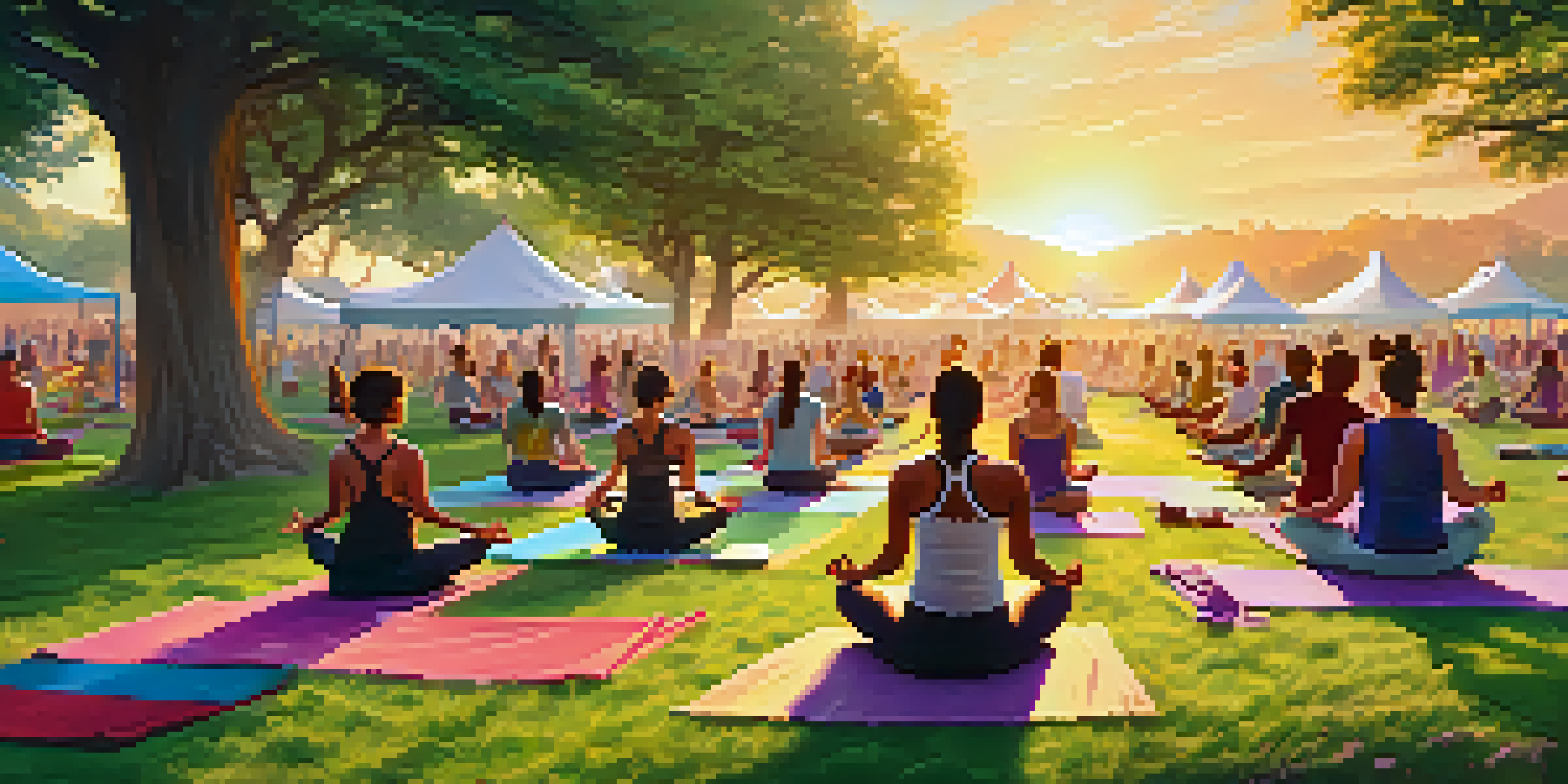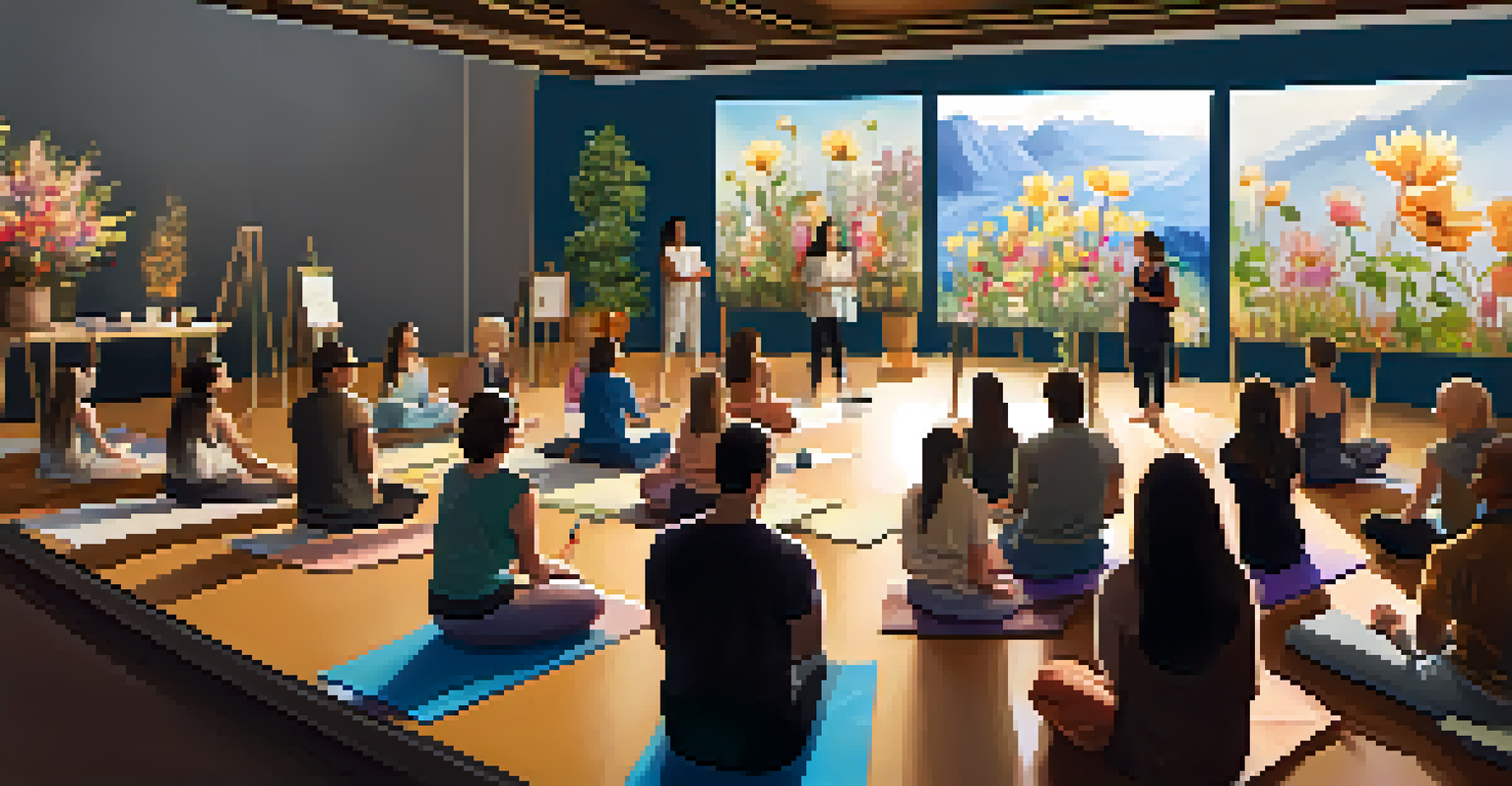The Evolution of Yoga Festivals Over the Years

The Roots of Yoga Festivals: Early Beginnings
Yoga festivals trace their origins back to ancient India, where spiritual gatherings were held to promote community and mindfulness. These early events focused primarily on the practice of yoga, meditation, and philosophical discussions. The essence of these gatherings was deeply rooted in tradition, emphasizing spiritual growth and the pursuit of enlightenment.
Yoga is not about touching your toes, it is what you learn on the way down.
As yoga began to spread globally in the 20th century, these festivals started to attract a more diverse audience. They transformed from exclusive spiritual retreats into communal celebrations of wellness, drawing in people from various backgrounds. This shift marked the beginning of a new era for yoga festivals, where accessibility became key.
In this early phase, the festivals were more about the teachings of yoga rather than the commercial aspects. However, as the popularity of yoga grew, so did the interest in these events, setting the stage for the evolution that would follow.
The Rise of Modern Yoga Festivals in the 1960s
The 1960s marked a significant turning point for yoga festivals, coinciding with the counterculture movement. Many Westerners began exploring Eastern philosophies, leading to a surge in interest in yoga as a holistic practice. This period saw the emergence of large-scale festivals that combined music, art, and yoga, creating a vibrant community atmosphere.

One of the most notable festivals from this era was the first Woodstock festival in 1969, which, while not strictly a yoga festival, included elements of spirituality and self-exploration that resonated with yogic principles. This blending of arts and wellness paved the way for future yoga festivals to embrace a more eclectic approach. Festivals began to incorporate not just yoga classes but also workshops on nutrition, meditation, and holistic living.
Yoga Festivals' Evolving Nature
Yoga festivals have transformed from exclusive spiritual gatherings into inclusive celebrations of wellness and community.
These modern festivals started to attract not just yogis but also musicians, artists, and wellness enthusiasts, creating a rich tapestry of experiences. The focus shifted from purely spiritual enlightenment to a more inclusive celebration of health, creativity, and community, reflecting a broader cultural shift.
The Influence of Technology on Yoga Festivals
With the advent of technology in the late 20th and early 21st centuries, yoga festivals began to evolve in new ways. Social media platforms like Facebook and Instagram made it easier to promote events, attracting a global audience. This digital presence allowed festivals to share their unique offerings and connect with potential attendees far beyond their geographical locations.
The mind is everything. What you think you become.
Moreover, technology enabled yoga festivals to diversify their content, offering live streams of classes and workshops for those who could not attend in person. This shift not only expanded their reach but also enhanced inclusivity, allowing people from various walks of life to participate in these transformative experiences. As a result, more individuals began to engage with yoga and wellness practices, regardless of their physical location.
Additionally, the rise of wellness apps and online platforms introduced a new layer of accessibility to yoga education. Festival organizers started integrating these tools, providing resources and tools that attendees could use beyond the festival itself, fostering a continuous journey of learning and growth.
Diversity and Inclusion at Yoga Festivals Today
In recent years, the focus on diversity and inclusion has become a prominent theme at yoga festivals. Organizers are increasingly aware of the need to represent a wide array of voices, backgrounds, and practices within the yoga community. This shift ensures that festivals resonate with a broader audience, making yoga more accessible to everyone.
Many festivals are now featuring a diverse lineup of teachers and speakers who bring unique perspectives and cultural practices to the forefront. By highlighting various styles and traditions, these events foster a sense of belonging and community among attendees. This inclusivity not only enriches the festival experience but also encourages participants to explore different aspects of yoga and wellness.
Diversity and Inclusion Focus
Modern yoga festivals emphasize diversity and inclusion, featuring a wide array of voices and practices to foster a sense of belonging.
Furthermore, many festivals are addressing issues such as body positivity and mental health, creating safe spaces for all attendees. Workshops and discussions centered around these topics emphasize the importance of holistic well-being and the need for representation in the wellness industry.
Sustainability Practices in Yoga Festivals
As awareness of environmental issues grows, many yoga festivals are embracing sustainability practices. Organizers are implementing eco-friendly measures, such as reducing plastic waste, promoting local vendors, and encouraging attendees to adopt sustainable travel habits. This commitment to the environment aligns with the yogic principle of ahimsa, or non-harming, extending compassion towards our planet.
Sustainable practices not only benefit the environment but also enhance the festival experience. Attendees are increasingly drawn to events that prioritize eco-consciousness, creating a sense of community among those who share similar values. By participating in these initiatives, festivals foster a collective responsibility towards the planet, encouraging attendees to carry these practices into their daily lives.
Moreover, many festivals now incorporate educational components focused on environmental awareness. Workshops on sustainable living, plant-based nutrition, and permaculture are becoming common, empowering attendees to make informed choices that positively impact the world around them.
The Role of Community in Yoga Festivals
At the heart of every yoga festival lies a deep sense of community. These gatherings serve as a melting pot for individuals seeking connection, support, and shared experiences. Attendees often form lasting friendships, encouraging one another on their individual yoga journeys, creating a powerful network of support.
The communal aspect of yoga festivals enhances the overall experience, as participants engage in group activities, such as collective meditations, chanting, and potluck meals. This sense of belonging fosters a unique atmosphere where individuals feel safe to express themselves and explore their spirituality. It's not just about yoga; it's about building relationships and nurturing a supportive environment.
Sustainability in Festival Practices
Many yoga festivals are adopting eco-friendly practices, aligning with yogic principles while enhancing the overall attendee experience.
Furthermore, the community aspect often extends beyond the festival itself. Many attendees leave with a renewed sense of purpose and connection, carrying the spirit of the festival into their daily lives. This ripple effect of community building illustrates the profound impact yoga festivals can have, encouraging connections that last long after the event has ended.
Looking Ahead: The Future of Yoga Festivals
As we look to the future, yoga festivals are poised to continue evolving in response to societal changes and emerging trends. The blending of technology, wellness, and community will likely drive the next wave of festival experiences. This evolution may see more hybrid models, combining in-person gatherings with virtual components to enhance accessibility for all.
Moreover, the focus on mental health and well-being is expected to remain a priority, with festivals offering more resources and workshops dedicated to these topics. As awareness grows around the importance of mental health, yoga festivals can serve as crucial platforms for discussion and healing. This emphasis aligns with the broader societal shift towards prioritizing mental well-being alongside physical health.

Ultimately, the future of yoga festivals will be defined by their ability to adapt and embrace diversity. By continually evolving to meet the needs of the community, these festivals can ensure that they remain relevant and impactful, fostering connections and promoting wellness for generations to come.